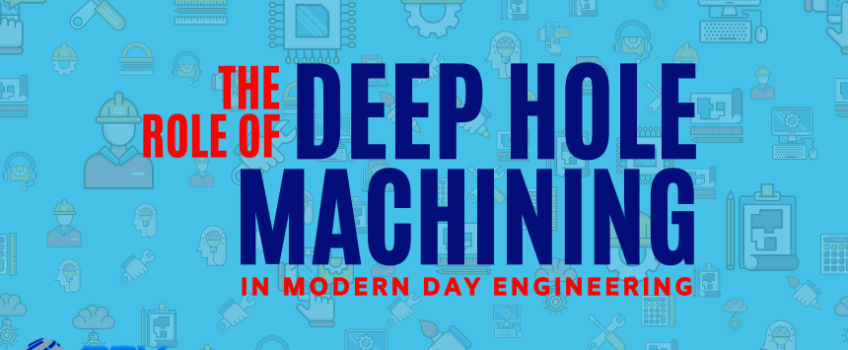
Deep Hole Machining (DHM) or Deep hole drilling (DHD) is a residual stress measurement technique also referred to as gun drilling. It’s prominent in engineering materials and components across various sectors, including automotive and vehicle construction, renewable energy and aerospace.
Deep hole machining is generally performed on dedicated machines to optimise the processes for straightness and efficiency. Today, advances in technology have allowed CNC machining centres, equipped with high pressure and through-spindle coolant, to also be capable of gun drilling up to a limited depth-to-diameter ratio.
Deep Hole Machining Equipment And Processes
Deep hole machining consists of BTA drilling and gun drilling, with a few other processes for specific tolerance objectives, generally performed on BTA-style equipment. Companies use gun drilling machines on a variety of materials, including super-alloys, capable of achieving tight diameter control, straightness, and superior surface finish.
The process works by using special tools and setups to:
- deliver high-pressure coolant
- evacuate chips cleanly
- achieve depth-to-diameter holes into metal
These machines can go beyond what a common CNC machine can reach, which allows manufacturers to reliably, accurately, and efficiently achieve their manufacturing tolerances and production requirements.
Deep Hole Machining Operating Procedures
When using an external coolant, the process should begin with a pilot hole from 1× to 2× diameter in length. This is followed by entry of the deep hole drill at roughly 500 rpm and 25-50% of the maximum feed rate. The slower feed rate and rpm reduce the risk of damaging the cutting edge of the drill.
Once into the pilot hole, drilling can proceed at 100% of the feed rate and speed until reaching the end of the cycle. Here, the drill is retracted which pulls out the chips from the hole whilst leaving the tip engaged to retain location.
When the chips are cleared, the cycle begins again until reaching the bottom. At this stage, the drill is retracted at 100% of the speed and 200-500% of the feed rate. The drill must continue to rotate once the hole is complete.
Deep Hole Drilling With Internal Coolant
The deep hole machining procedure for internal coolant is very similar where it also starts with a pilot drill. With the coolant off, the drill should enter the pilot hole at about 500 rpm and anywhere from 200-300% feed rate.
If you turn on the coolant too early, the drill will whip around and most likely won’t enter the pilot hole cleanly which could cause it to break. The coolant should be turned on once the drill is inside the pilot hole and made sure to run at 100% of the speed and feed rate.
After reaching the bottom, the drill should be retracted at the maximum feed rate whilst rotating it at roughly 500 rpm. During this process, the coolant should be turned off before removing the drill from the hole.
What About The Call For Multi-Tasking Machining Centres?
A notable current trend in deep hole machining (DHM) is multitasking. Just like achieving common machining techniques (milling, turning and gear-cutting) on a single machine tool platform, there is a growing need for deep hole drilling to follow the same format.
The primary reason stems from the aerospace industry where companies have to produce several high-value components, including landing gear parts. Traditionally, producing these components requires dedicated machines but the call for consolidated operations could result in a single multitask platform capable of more, which offers significant benefits to end-users.
Advantages Of Multi-tasking Deep Hole Drilling Machines
The biggest benefit is quality as there will be higher concentricity between diameters as a result of completing all operations on a single machine. This means not having to transfer heavy and high-value components between different machines which helps minimise the risk of any potential for errors whilst enhancing productivity due to saving time in setup.
Developing a multitasking platform that includes deep hole machining creates a “green light process”. Put plainly, this means operators can simply press the start button and walk away, allowing the machine to safely and accurately produce the completed component.
In large aerospace OEMs (Original Equipment Manufacturers), these green light processes are essential to maximising the utilisation of machines.
Recommended: ‘Tools And Technologies For Deep Hole Drilling’
Final Thoughts
Deep holes are present in several applications across various sectors where each one has a set of strict requirements and unique challenges. Whilst some may need tighter tolerances, others could require tougher materials or a higher production goal.
Considering the scope of practice, deep hole machining requires a particular degree of expertise only a few engineering companies can offer. PRV is one of Europe’s top suppliers of precision engineering services with the ability to manage all of your deep hole drilling requirements.
We deliver a “complete, customised service” thanks to our continued investment in acquiring and training highly skilled staff and state-of-the-art machinery. For more info about our products and service, please visit the website and join the interesting conversations on social media using the hashtag #PRVtech.
This site uses Akismet to reduce spam. Learn how your comment data is processed.


 Mail:
Mail: 




Leave a Comments